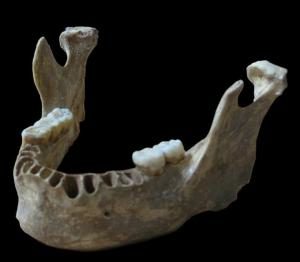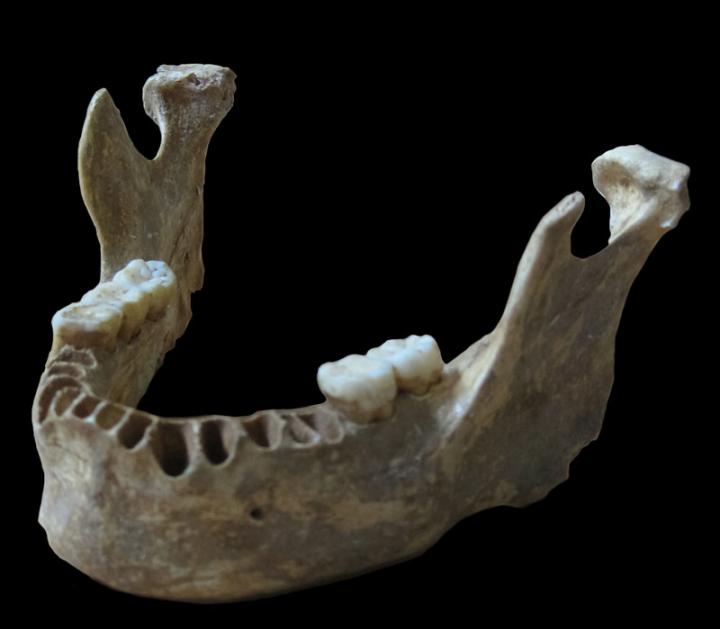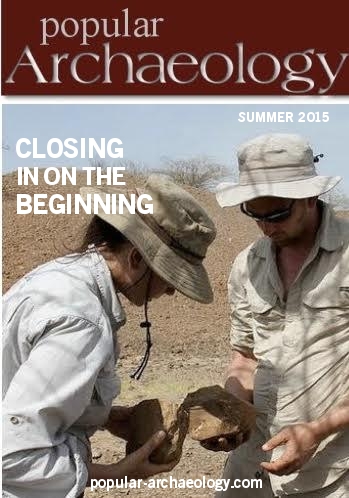
Researchers have concluded that an early modern human who lived in present-day Romania about 40,000 years ago had a Neanderthal ancestor who lived just 4 to 6 generations back in the individual’s family tree.
Co-led by Svante Pääbo of the Max Planck Institute for Evolutionary Anthropology in Leipzig, Germany and Howard Hughes Medical Institute (HHMI) investigator David Reich at Harvard Medical School, along with researchers at the Key Laboratory of Vertebrate Evolution and Human Origins in Beijing, China, researchers were able to tease out and analyze a small percentage of the DNA remnants found in a 37,000 to 42,000-year-old modern human jaw bone originally found in 2002 by cavers and archaeologists in the Oase Cave in south-western Romania.
“I could hardly believe it when we first saw the results,” said Pääbo. “It is such a lucky and unexpected thing to get DNA from a person who was so closely related to a Neanderthal.”
The task was not an easy one.
Trace amounts of ancient DNA can be recovered from bones as old as the Oase jawbone, but to analyze it, that ancient DNA must be sifted out of an overwhelming amount of DNA from other organisms. When Qiaomei Fu, who was a graduate student in Pääbo’s lab, obtained DNA from the bone, most of it was from microbes that lived in the soil where the bone was found. Of the fraction of a percent that was human DNA, most had been introduced by people who handled the bone after its discovery.
Using methods pioneered in Pääbo’s lab, Fu enriched the proportion of human DNA in the sample, using genetic probes to retrieve pieces of DNA that spanned any of 3.7 million positions in the human genome that are considered useful in evaluating variation between human populations. Most of the DNA she ended up with was human, but came from people who had handled the jawbone since 2002, rather than the jawbone itself. Fu, who is now a postdoctoral researcher in Reich’s group, solved that problem by restricting her analysis to DNA with a kind of damage that deteriorates the molecule over tens of thousands of years. Once they had discarded the contaminating DNA, Reich’s team could then compare the fossil’s genome to genetic data from other groups. Through a series of statistical analyses, a surprising conclusion emerged.
“The sample is more closely related to Neanderthals than any other modern human we’ve ever looked at before,” Reich says. “We estimate that six to nine percent of its genome is from Neanderthals. This is an unprecedented amount. Europeans and East Asians today have more like two percent.”
____________________________________________
 DNA taken from a 40,000-year-old modern human jawbone reveals that this man had a Neandertal ancestor as recently as four to six generations back. Courtesy MPI f. Evolutionary Anthropology/Paabo
DNA taken from a 40,000-year-old modern human jawbone reveals that this man had a Neandertal ancestor as recently as four to six generations back. Courtesy MPI f. Evolutionary Anthropology/Paabo
___________________________________________________________
 For their analysis the researchers used 35 milligrams of bone powder from the jawbone. Courtesy MPI f. Evolutionary Anthropology/Paabo
For their analysis the researchers used 35 milligrams of bone powder from the jawbone. Courtesy MPI f. Evolutionary Anthropology/Paabo
_____________________________________________________________
The implications of the finding are significant. Neanderthals lived in Europe until about 35,000 years ago, disappearing at the same time modern humans were spreading across the continent.
“We know that before 45,000 years ago, the only humans in Europe were Neanderthals. After 35,000 years ago, the only humans in Europe were modern humans. This is a dramatic transition,” Reich says.
All present-day humans who have their roots outside sub-Saharan Africa carry one to three percent of Neanderthal DNA in their genomes. Until now, researchers have thought it most likely that early humans coming from Africa mixed with Neanderthals in the Middle East around 50,000 to 60,000 years ago, before spreading into Asia, Europe and the rest of the world. However, radiocarbon dating of remains from sites across Europe suggests that modern humans and Neanderthals both lived in Europe for up to 5,000 years and that they may have interbred there, too. There is archaeological evidence for this: Changes in tool making technology, burial rituals, and body decoration imply a cultural exchange between the groups. “But we have very few skeletons from this period,” said Reich.
So the jawbone that archaeologists uncovered in Romania in 2002, which radiocarbon dating determined was between 37,000 and 42,000 years old, was an important find. “It’s an amazing bone,” Reich says. The jawbone was found along with the skull of another individual in a cave called Petera cu Oase. No artifacts were discovered nearby, so anthropologists had no cultural clues about who the individuals were or how they lived. The physical features of the jawbone were predominantly those of modern humans, but some Neanderthal traits were also apparent, and the anthropologists proposed that the bone might have belonged to someone descended from both groups.
The Oase individual is not responsible for passing Neanderthal ancestry on to present day humans, however. Reich found no evidence that he is closely related to later Europeans. “This sample, despite being in Romania, doesn’t yet look like Europeans today,” he says. “It is evidence of an initial modern human occupation of Europe that didn’t give rise to the later population. There may have been a pioneering group of modern humans that got to Europe, but was later replaced by other groups.”
Nonetheless, the Oase fossil discovery is now a first on two counts: “When we started the work on the Oase site, everything was already pointing to an exceptional discovery,” remembers Oana Moldovan, the Romanian researcher who initiated the systematic excavation of the cave in 2003. “But such discoveries require painstaking research to be confirmed,” adds Silviu Constantin, her colleague who worked on dating of the site. “We have previously shown that Oase is indeed the oldest modern human in Europe known so far, and now this research confirms that the individual had a Neanderthal ancestor. What more could we wish for?”
The detailed paper is published in the journal Nature.
_______________________________________________________
Adapted and edited from material provided by press releases of the Max Planck Institute and the Howard Hughes Medical Institute.
_______________________________________________________
 Read more in-depth articles about archaeology with a premium subscription to Popular Archaeology Magazine.
Read more in-depth articles about archaeology with a premium subscription to Popular Archaeology Magazine.
In addition, the latest Popular Archaeology ebook is now available.
______________________________________________
Travel and learn with Far Horizons.
____________________________________________
 Popular Archaeology’s annual Discovery Edition eBook is a selection of the best stories published in Popular Archaeology Magazine in past issues, with an emphasis on some of the most significant, groundbreaking, or fascinating discoveries in the fields of archaeology and paleoanthropology and related fields. At least some of the articles have been updated or revised specifically for the Discovery edition. We can confidently say that there is no other single issue of an archaeology-related magazine, paper print or online, that contains as much major feature article content as this one. The latest issue, volume 2, has just been released. Go to the Discovery edition page for more information.
Popular Archaeology’s annual Discovery Edition eBook is a selection of the best stories published in Popular Archaeology Magazine in past issues, with an emphasis on some of the most significant, groundbreaking, or fascinating discoveries in the fields of archaeology and paleoanthropology and related fields. At least some of the articles have been updated or revised specifically for the Discovery edition. We can confidently say that there is no other single issue of an archaeology-related magazine, paper print or online, that contains as much major feature article content as this one. The latest issue, volume 2, has just been released. Go to the Discovery edition page for more information.
____________________________________________







